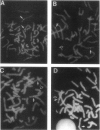Abstract
Molecular cloning of a microdissected small accessary ring chromosome 4 from a moderately retarded and dysmorphic patient has been performed to identify the origin of the ring chromosome. FISH was performed with cosmids identified with the cloned, microdissected products and with other markers from chromosome 4. The present study clearly demonstrates that the small ring in this patient originates from three discontinuous regions of chromosome 4: 4p13 or 14, the centromere, and 4q31. It is suggested that the origin of the ring chromosome is a ring involving the entire chromosome 4, which has then been involved in breakage and fusion events, as a consequence of DNA replication generating interlocked rings. A second severely retarded and dysmorphic patient also had a small accessary ring derived from chromosome 4. FISH studies of this ring are consistent with an origin from a contiguous region including the centromere to band 4q12. It is apparent that there are at least two mechanisms for the formation of small ring chromosomes. This adds a further complication in any attempt to ascertain common phenotypes between patients known to have morphologically similar markers derived from the same chromosome.
Full text
PDF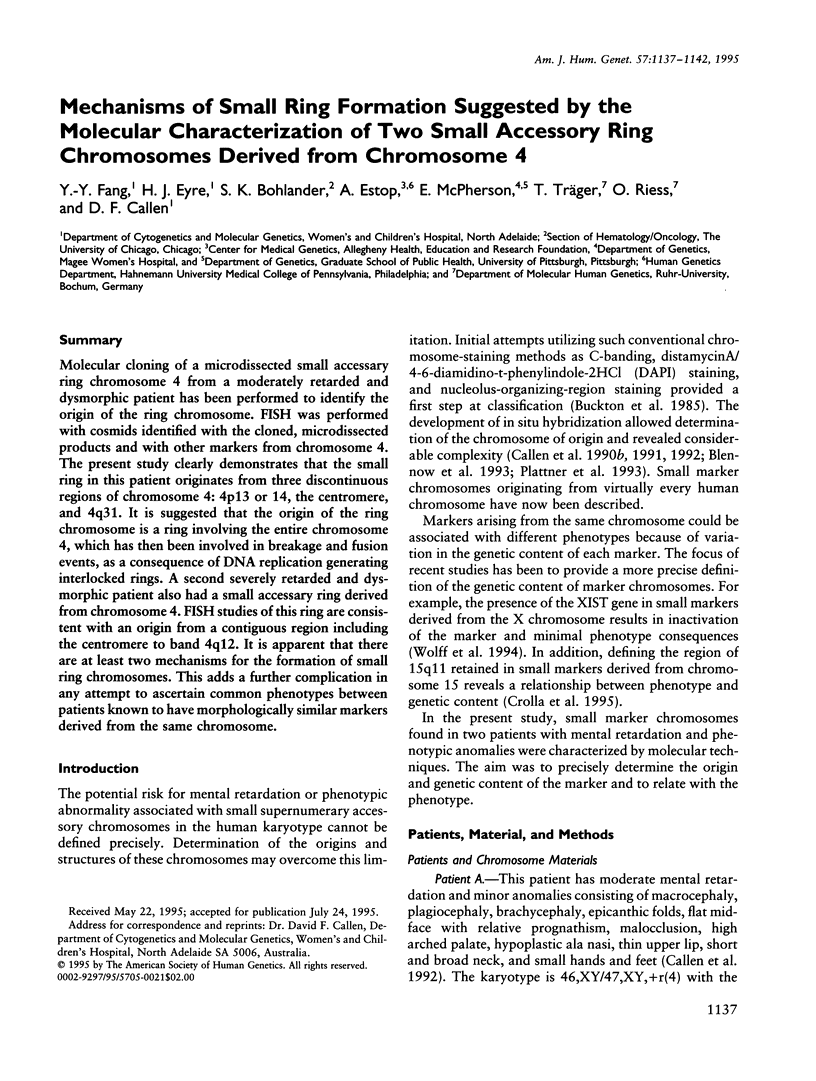
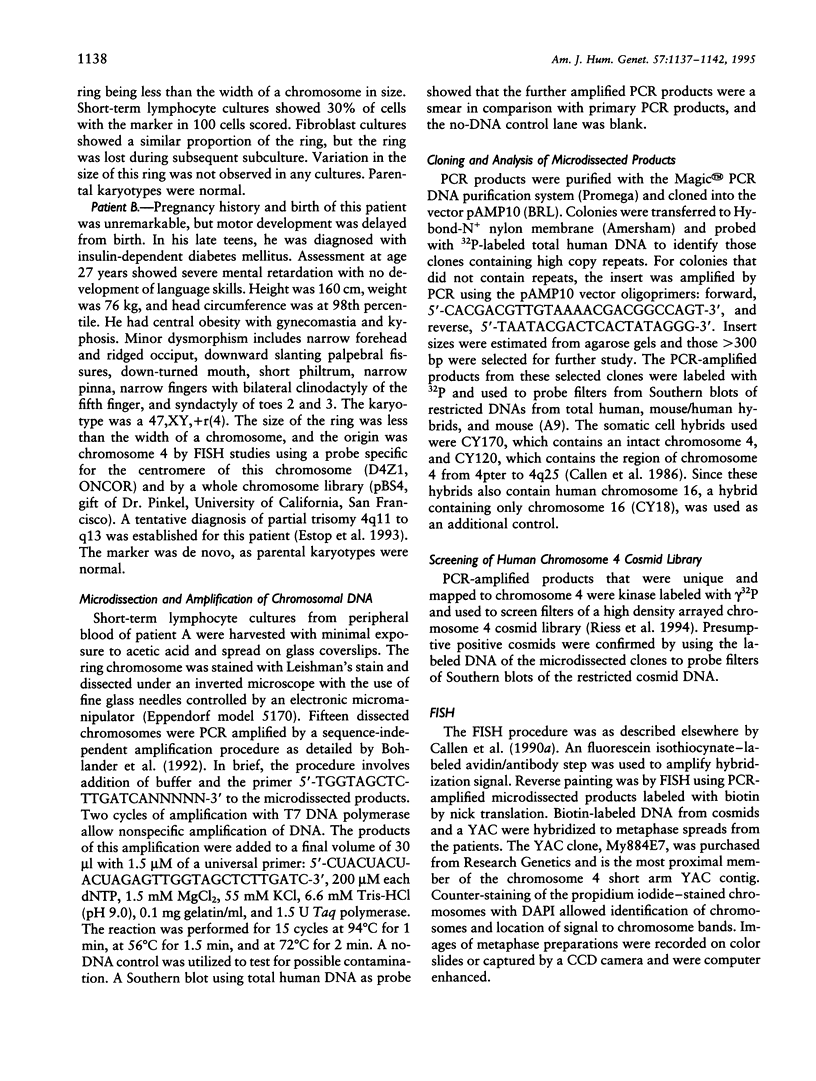
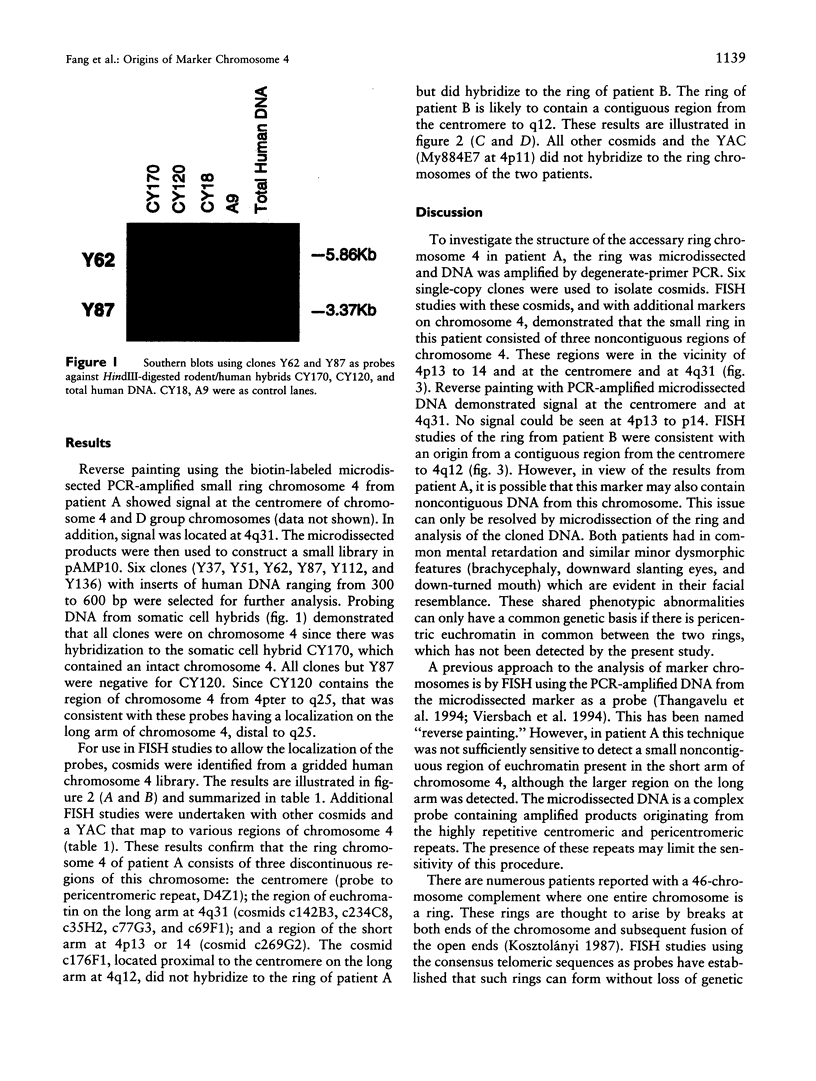

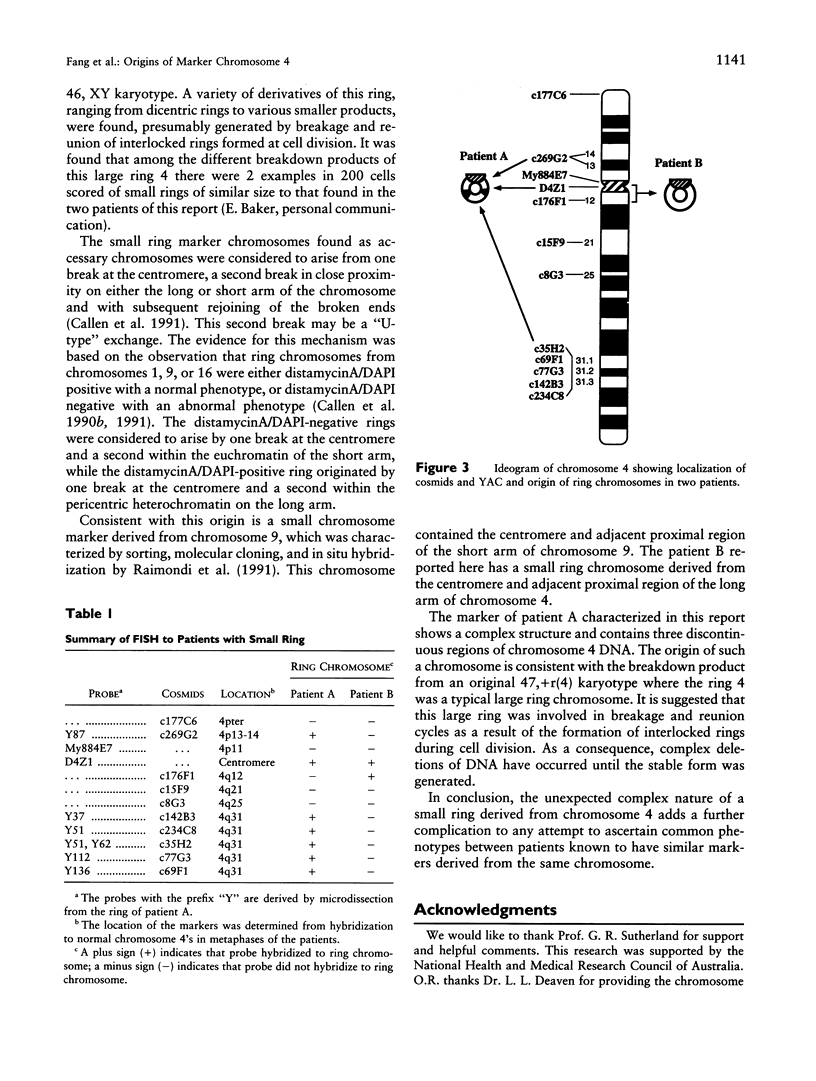
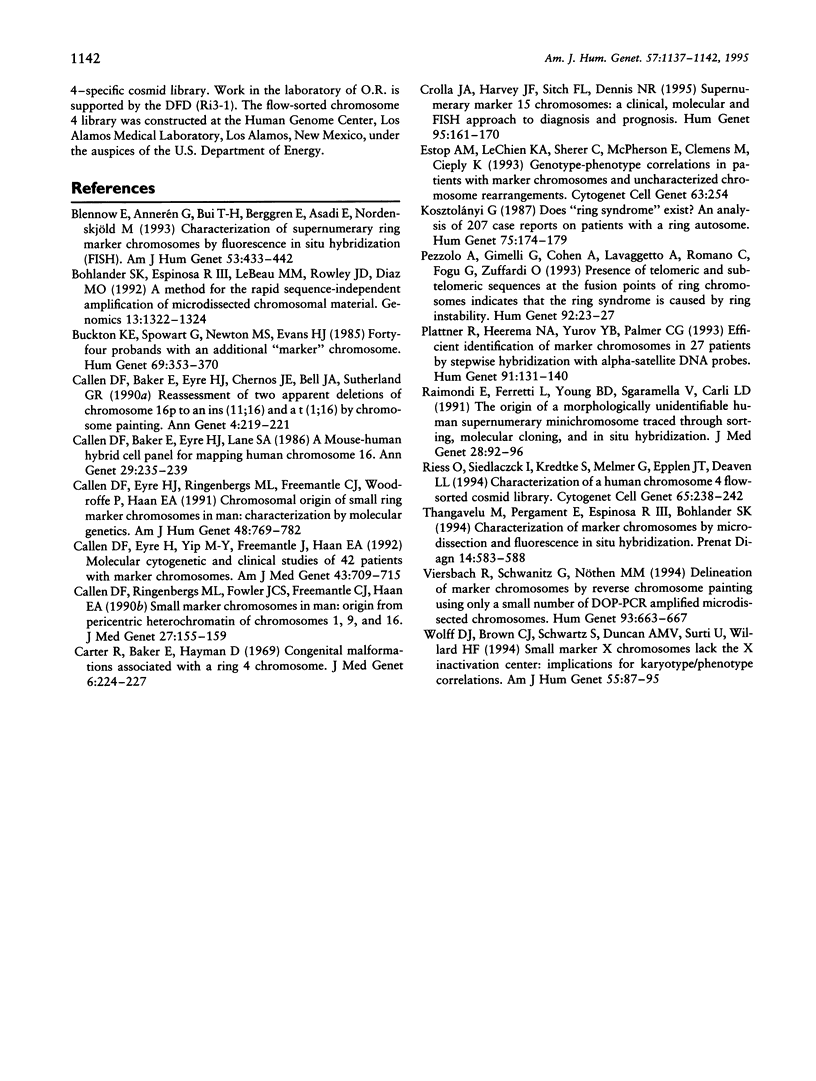
Images in this article
Selected References
These references are in PubMed. This may not be the complete list of references from this article.
- Blennow E., Annerén G., Bui T. H., Berggren E., Asadi E., Nordenskjöld M. Characterization of supernumerary ring marker chromosomes by fluorescence in situ hybridization (FISH). Am J Hum Genet. 1993 Aug;53(2):433–442. [PMC free article] [PubMed] [Google Scholar]
- Bohlander S. K., Espinosa R., 3rd, Le Beau M. M., Rowley J. D., Díaz M. O. A method for the rapid sequence-independent amplification of microdissected chromosomal material. Genomics. 1992 Aug;13(4):1322–1324. doi: 10.1016/0888-7543(92)90057-y. [DOI] [PubMed] [Google Scholar]
- Buckton K. E., Spowart G., Newton M. S., Evans H. J. Forty four probands with an additional "marker" chromosome. Hum Genet. 1985;69(4):353–370. doi: 10.1007/BF00291656. [DOI] [PubMed] [Google Scholar]
- Callen D. F. A mouse-human hybrid cell panel for mapping human chromosome 16. Ann Genet. 1986;29(4):235–239. [PubMed] [Google Scholar]
- Callen D. F., Baker E., Eyre H. J., Chernos J. E., Bell J. A., Sutherland G. R. Reassessment of two apparent deletions of chromosome 16p to an ins(11;16) and a t(1;16) by chromosome painting. Ann Genet. 1990;33(4):219–221. [PubMed] [Google Scholar]
- Callen D. F., Eyre H. J., Ringenbergs M. L., Freemantle C. J., Woodroffe P., Haan E. A. Chromosomal origin of small ring marker chromosomes in man: characterization by molecular genetics. Am J Hum Genet. 1991 Apr;48(4):769–782. [PMC free article] [PubMed] [Google Scholar]
- Callen D. F., Eyre H., Yip M. Y., Freemantle J., Haan E. A. Molecular cytogenetic and clinical studies of 42 patients with marker chromosomes. Am J Med Genet. 1992 Jul 1;43(4):709–715. doi: 10.1002/ajmg.1320430412. [DOI] [PubMed] [Google Scholar]
- Callen D. F., Ringenbergs M. L., Fowler J. C., Freemantle C. J., Haan E. A. Small marker chromosomes in man: origin from pericentric heterochromatin of chromosomes 1, 9, and 16. J Med Genet. 1990 Mar;27(3):155–159. doi: 10.1136/jmg.27.3.155. [DOI] [PMC free article] [PubMed] [Google Scholar]
- Carter R., Baker E., Hayman D. Congenital malformations associated with a ring 4 chromosome. J Med Genet. 1969 Jun;6(2):224–227. doi: 10.1136/jmg.6.2.224. [DOI] [PMC free article] [PubMed] [Google Scholar]
- Crolla J. A., Harvey J. F., Sitch F. L., Dennis N. R. Supernumerary marker 15 chromosomes: a clinical, molecular and FISH approach to diagnosis and prognosis. Hum Genet. 1995 Feb;95(2):161–170. doi: 10.1007/BF00209395. [DOI] [PubMed] [Google Scholar]
- Kosztolányi G. Does "ring syndrome" exist? An analysis of 207 case reports on patients with a ring autosome. Hum Genet. 1987 Feb;75(2):174–179. doi: 10.1007/BF00591082. [DOI] [PubMed] [Google Scholar]
- Pezzolo A., Gimelli G., Cohen A., Lavaggetto A., Romano C., Fogu G., Zuffardi O. Presence of telomeric and subtelomeric sequences at the fusion points of ring chromosomes indicates that the ring syndrome is caused by ring instability. Hum Genet. 1993 Aug;92(1):23–27. doi: 10.1007/BF00216140. [DOI] [PubMed] [Google Scholar]
- Plattner R., Heerema N. A., Yurov Y. B., Palmer C. G. Efficient identification of marker chromosomes in 27 patients by stepwise hybridization with alpha-satellite DNA probes. Hum Genet. 1993 Mar;91(2):131–140. doi: 10.1007/BF00222713. [DOI] [PubMed] [Google Scholar]
- Raimondi E., Ferretti L., Young B. D., Sgaramella V., De Carli L. The origin of a morphologically unidentifiable human supernumerary minichromosome traced through sorting, molecular cloning, and in situ hybridisation. J Med Genet. 1991 Feb;28(2):92–96. doi: 10.1136/jmg.28.2.92. [DOI] [PMC free article] [PubMed] [Google Scholar]
- Riess O., Siedlaczck I., Kredtke S., Melmer G., Epplen J. T., Deaven L. L. Characterization of a human chromosome 4 flow-sorted cosmid library. Cytogenet Cell Genet. 1994;65(4):238–242. doi: 10.1159/000133638. [DOI] [PubMed] [Google Scholar]
- Thangavelu M., Pergament E., Espinosa R., 3rd, Bohlander S. K. Characterization of marker chromosomes by microdissection and fluorescence in situ hybridization. Prenat Diagn. 1994 Jul;14(7):583–588. doi: 10.1002/pd.1970140712. [DOI] [PubMed] [Google Scholar]
- Viersbach R., Schwanitz G., Nöthen M. M. Delineation of marker chromosomes by reverse chromosome painting using only a small number of DOP-PCR amplified microdissected chromosomes. Hum Genet. 1994 Jun;93(6):663–667. doi: 10.1007/BF00201567. [DOI] [PubMed] [Google Scholar]
- Wolff D. J., Brown C. J., Schwartz S., Duncan A. M., Surti U., Willard H. F. Small marker X chromosomes lack the X inactivation center: implications for karyotype/phenotype correlations. Am J Hum Genet. 1994 Jul;55(1):87–95. [PMC free article] [PubMed] [Google Scholar]




